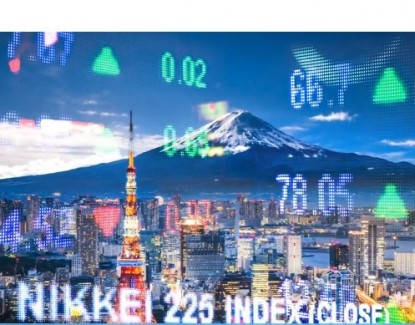Market Commentary and Fund Performance
The Portfolio Managers of Tokyo-based SPARX Asset Management Co., Ltd., sub-advisor to the Hennessy Japan Fund, share their insights on the Japanese market and Fund performance.
-
 Masakazu Takeda, CFA, CMAPortfolio Manager
Masakazu Takeda, CFA, CMAPortfolio Manager
Performance data quoted represents past performance; past performance does not guarantee future results. The investment return and principal value of an investment will fluctuate so that an investor’s shares, when redeemed, may be worth more or less than their original cost. Current performance of the fund may be lower or higher than the performance quoted. Performance data current to the most recent month end, and standardized performance can be obtained by viewing the fact sheet or by clicking here.
Fund Performance Review
In October 2024, the TOPIX, which is a representative index of the Japanese stock market, declined 4.33% from the end of the previous month.
Early in the month, the prospect of a rate cut receded due to factors such as the fact that U.S. Federal Reserve Chairman Jerome Powell, who spoke at the annual meeting of the National Association for Business Economics, emphasized that there was “no need to rush” when it came to future rate cuts. This, combined with U.S. employment statistics greatly exceeding market expectations and cautious views expressed by Prime Minister Shigeru Ishiba regarding the Bank of Japan’s (BOJ) another raising interest rate at early timing, led to a stronger dollar against the yen. Although stock prices temporarily fell due to the worsening situation in the Middle East, as mentioned above, the stock market rose due to factors such as the continuing depreciation of the yen, the resilience of the U.S. economy, and confirmation that the Ishiba administration would continue the economic policies of the previous Kishida administration.
In the latter half of the month, there was a broad sell-off in semiconductor-related stocks after the earnings forecast for the fiscal year ending December 2025 was lowered in the earnings announcement by ASML Holding, a major Dutch semiconductor equipment manufacturer. In addition, the long-term interest rates in Japan and the U.S. continued to rise, and it was reported that the ruling Liberal Democratic Party and Komeito Party were in a delicate situation in terms of securing a majority of seats in the House of Representatives election, which was held on the 27th. These factors and more led to a weak market.
Following the House of Representatives election, the ruling coalition party lost its majority for the first time in 15 years since 2009, and there was a growing view that the future framework of the government would be a “partial coalition” in which the minority ruling party would seek cooperation from the opposition on a policy or bill-by-bill basis. The stock market changed completely after the House of Representatives election and closed the month up from the end of the previous month, due to factors such as the awareness of the possibility of the implementation of economic stimulus policies through cooperation with the opposition party, which advocates expansionary fiscal policies, and the repurchase of futures after the risk events were passed.
This month, the Fund returned -6.54% (HJPIX), underperforming its reference index, the Russell/Nomura Total Market™ Index, which returned -4.68%.
The month’s positive performer among the Global Industry Classification Standard (GICS) sectors included shares of Communication Services, while Industrials, Information Technology, and Consumer Staples detracted from the Fund’s performance.
Among the best performers were our investments in Recruit Holdings Co., Ltd., Japan’s unique human resources (HR) and media company and the owner of U.S.-based online job advertisement subsidiary Indeed, Mitsubishi UFJ Financial Group, Inc., one of Japan’s largest financial groups and Hitachi, Ltd., one of Japan’s oldest electric equipment & heavy industrial machinery manufacturers.
As for the laggards, Tokyo Electron Limited, one of the world’s largest manufacturer of semiconductor production equipment, Daikin Industries, Ltd., the leading global manufacturer of commercial-use air conditioners and and Mitsubishi Corporation, the largest trading company in Japan.
Thoughts on the research process
Stock investment based on fundamental research requires forecasting the future, and as we all know, the future is rife with uncertainties. To minimize the probability of permanent capital loss on investment mistakes, an intelligent investor should always start from the point of assuming that the future is extremely difficult to predict. Therefore, we can only think of two approaches to making sound investment decisions. Both begin with the same premise:
1. The future is unknown. Thus, one should only invest in businesses with a consistent long-term operating history such that its future can be extrapolated linearly and ensure to buy such stocks at a reasonable price (or less).
2. The future is unknown. Thus, one should ignore the past and focus on businesses with transformative potential but ensure to buy such stocks at a sufficiently low price.
Between these two types of businesses, the future tends to be “less unpredictable” for type 1 due to their time-tested record of accomplishment. This means their stock prices are seldom available at bargain-basement levels, so you need to settle for a “reasonable price.”
In type 2, you are almost unable to make an educated guess about what the future might hold. A careless assumption may lead to a significant miss on the forecast and result in a sharp decline in the share price. To protect against such risk, you should be prepared to pay only a dirt-cheap price. Either approach is sound and sensible, and our investment style largely falls into the former camp.
In our research, the typical thought process starts with examining the long-term history of the business. The objective is to understand whether the business has prospered over the years without its competitive edge (the moat) being undermined by external threats or changes in the industry landscape.
Once done with “the past,” we then turn our attention to “the present” and analyze whether the moat remains intact today and if there are any signs of impending tectonic shifts in the industry that could potentially upend the company’s market position. If the answer to these questions is a resounding “No,” then the last part of the process is to think about “the future.”
Our aim here is to determine if there is reasonably predictable demand growth for the company’s products or services. For ubiquitous consumer products or daily essentials with high consumer mindshare, projecting revenue growth based on the predictable growth of the world population is often the easiest and surest method.
One of our past investments, Shimano, is a case in point. The world’s dominant high-end bicycle parts supplier had a remarkable record of accomplishment in the years leading up to 2007, the year we initiated the position. Over nearly fifty years in business, Shimano’s market share had never been threatened, maintaining an estimated global market share of 70-80% throughout its history. The company’s success can be attributed to 1 the manufacturing excellence in its metal shaping technique known as “cold forging,”1 and 2 a positive feedback loop enabled by its close relationship with the world’s top bicycle racers.
Shimano supplies key components to eight out of every 10 teams at the Tour de France. These teams provide feedback on product performance to Shimano’s technical team, which is then reflected in the next year’s model for further improvement. Such a feedback loop is hard to displace because product knowledge accumulates much faster than at weaker rivals. This serves as a strong moat.
Furthermore, we note that Shimano’s premier brand image, cultivated through endorsements from top racers, naturally extends to ordinary consumers. For these reasons, we saw Shimano as a rare business where a business-to-business parts supplier possesses competitive advantages in terms of both economies of scale on the manufacturing side and superior brand recognition as a consumer business.
Moving our research focus from “the past” to “the present,” at the time of our research around 2007, we confirmed that the bicycle industry showed no signs of dramatic structural shifts (like the current changes in the automotive industry). The mechanics of bicycles have remained largely unchanged since the first chain-drive model was invented around 1885 in Europe (the frame, pedals, chain, handle, suspension, wheels, saddle, brake, gears etc). This gave us comfort, as it indicated that the future of the bicycle industry was unlikely to change significantly,2 making it less challenging to project the future. In a way, it is a mundane business, but oftentimes an excellent business is hiding in plain sight.
Lastly, regarding future prospects, we were fairly confident that global bicycle shipments would only increase over time for several reasons: 1) The world population was certain to grow, 2) As people in developed countries became more health and environmentally conscious, bicycles were highly likely to become the preferred mode of transportation or choice of recreation for physical exercise, and 3) People in emerging countries were expected to enjoy more leisure activities due to improving living standards. All these factors should positively impact global bicycle demand. Considering all these points, we concluded that the likelihood of Shimano maintaining a healthy revenue and earnings growth rate for at least the next several years, as an extension of the past, was high.
In terms of the types of information gathered for our research, we often use document-based resources (i.e., reading is our primary research work). All we can access is publicly disclosed information such as regulatory filings, annual reports, investor presentation materials, earnings call transcripts, industry news/articles, management interviews, industry periodicals, library resources, and other online resources.
We have noticed that our time for direct company interviews is somewhat limited. While we appreciate the insights shared during face-to-face meetings with management or investor relations staff, we sometimes find that the discussions can lean towards an overly optimistic view of business prospects (promoting their stock to investors). We believe that a more balanced perspective could enhance our understanding of the company’s situation. To remain a truly independent thinker, it is better to avoid unwanted biases as much as possible. Luckily, there is no shortage of documented information for well-established, large market cap companies that we invest in.
While information sources can be wide-ranging and the amount of available public information can be overwhelming, there are only particular types of information we seek out:
1. Information with long-lasting usefulness:
Long-term financial performance data, information about the outcomes of management’s long-term business decisions, and aspects that define corporate culture provide valuable, cumulative insights. On the other hand, monthly sales data and quarterly earnings have a limited shelf-life as they quickly become obsolete within a few weeks to a few months, making their importance nearly negligible in the grand scheme of things.
2. Factual information rather than prediction or opinion:
We make a conscious effort to focus on factual information such as historical financial results and industry data. In contrast, any sort of forward-looking statements should not be relied upon too much, even if provided by company management (or “insiders”). Third-party experts’ opinions (sell-side analysts, TV commentators, etc) can also unnecessarily influence your view or, worse yet, impair your judgment. When it comes to future predictions, “experts” are too often outsmarted by “non-experts” as we argued in our September 2021 letter citing the book “The Wisdom of Crowds.”
The only thing that might be worth paying attention to is diverse opinions collected from the masses, such as customer reviews. However, you must be aware of fake online reviews and other factors. You also need to understand the psychology of someone who takes the time to write reviews; these individuals often had either an extremely positive or negative experience. In other words, we may be seeing only marginal opinions. The bottom line is, that once you have accumulated enough knowledge and insights, you should be able to independently form your own opinion and projection, rather than relying on others.
3. Signal not noise:
Most types of information that come across daily in the news can be dismissed as just “noise.” A temporary blip in same-store sales numbers for a retailer due to unfavorable weather conditions is noise, for example. we would dismiss it completely, even though the news may cause the share price to drop. The key is to distinguish between “noise” and “signal.” It is important to be on the lookout for the latter rather than the former. We consider a “signal” as an event which could alter the fate of the business to a point where its intrinsic value will be significantly affected. Developments such as structural shifts in consumer behaviors and technological changes come to mind as examples of this.
4. Being qualitative can be just as important as quantitative:
Qualitative information about a business hardly transmits from person to person because such information is more ambiguous and cannot be substantiated by numbers. Research findings such as “this company has achieved 10% return on equity (ROE) for 10 consecutive years” or “revenue growth of 10%” are quantitative, while observations such as “the company’s corporate culture is very resilient” or “strong management leadership should make the company an industry winner” are qualitative and more difficult to convince others. This is because humans prefer to base their decisions on certainty rather than abstract information. Therefore, if you can come to your conclusion based on a qualitative assessment of the business, it is more likely to be a non-consensus view than an investment view formed around quantitative data. As we discussed in the September 2021 letter, being different from consensus is a prerequisite to outperforming the index.
Using eclectic and voracious reading as a source of alpha
At the beginning of this writing, we mentioned that our investment approach generally calls for a close study of a business’s past and trying to predict its future by extrapolating linearly. The research is done primarily through reading rather than interviewing. We pore over numerous document resources to gain knowledge and follow the same companies in our universe over many years. Incidentally, this helps us overcome the handicap of not visiting the companies. While we may miss the “feel-good factor” that you sometimes gain from company visits, we can still develop high conviction about our investees by observing them over a much longer period.
“Research by reading” is not just about learning about a particular company’s history. It is about accumulating knowledge on a wide range of topics for better decision-making, including understanding new industries, new technologies, various business models, and other important trends. To this end, we also study foreign businesses outside of the Fund’s universe, even when they have no relevance to the current holdings.
The idea behind all this is “collecting dots” for future use. Even though new findings (or new “dots”) are not readily actionable as investment ideas, by being an eclectic and voracious reader, we hope to connect the dots at some point to give us the “a-ha” moment, which eventually leads to a portfolio action. The process is different from reading and knowing about the company’s past and extrapolating it. Rather, it is more like attempting to draw parallels between a successful business model born overseas and an investment candidate in Japan where such a case might be applicable. This approach led us to invest in Recruit Holdings, Sony Group, and Hitachi over the last several years. We believe this is a wise approach to identifying the next “big thing” in Japan.
Click here for a full listing of Holdings.
- In this article:
- Japan
- Japan Fund
1 Cold forging is a process that takes place near room temperature, rather than at higher temperatures like warm and hot forging. It is often more economical than other processes because the final product does not require much finishing. It is suitable for mass-production of metal components, allowing for cost competitiveness.
2 The last decade has seen the proliferation of eBike, or electric bicycle. However, whether it is mechanical bikes or eBikes, the industry must rely on Shimano for key parts such as gears and braking systems.
You might also like
-
 Portfolio Perspective
Portfolio Perspective
Japan FundJapan’s Evolving Investment Landscape in 2025
 Masakazu Takeda, CFA, CMAPortfolio Manager
Masakazu Takeda, CFA, CMAPortfolio Manager Angus Lee, CFAPortfolio Manager
Angus Lee, CFAPortfolio Manager Kohei MatsuiPortfolio ManagerRead the Commentary
Kohei MatsuiPortfolio ManagerRead the CommentaryIn the following commentary, the Hennessy Japan Fund Portfolio Managers summarized what most surprised them in 2024 about the Japanese market along with positive trends driving Japanese companies.
-
 Investment Idea
Investment IdeaCompelling Valuations in Japan
 Masakazu Takeda, CFA, CMAPortfolio Manager
Masakazu Takeda, CFA, CMAPortfolio Manager Tadahiro Fujimura, CFA, CMAPortfolio Manager
Tadahiro Fujimura, CFA, CMAPortfolio Manager Takenari Okumura, CMAPortfolio ManagerRead the Investment Idea
Takenari Okumura, CMAPortfolio ManagerRead the Investment IdeaJapanese equities are currently trading at compelling valuation levels compared to other developed equity markets around the world and relative to their own historical averages. We believe the Japanese market deserves a closer look.
-
 Investment Idea
Investment IdeaWhy Active Matters When Investing in Japan
 Masakazu Takeda, CFA, CMAPortfolio Manager
Masakazu Takeda, CFA, CMAPortfolio Manager Angus Lee, CFAPortfolio Manager
Angus Lee, CFAPortfolio Manager Kohei MatsuiPortfolio Manager
Kohei MatsuiPortfolio Manager Tadahiro Fujimura, CFA, CMAPortfolio Manager
Tadahiro Fujimura, CFA, CMAPortfolio Manager Takenari Okumura, CMAPortfolio ManagerRead the Investment Idea
Takenari Okumura, CMAPortfolio ManagerRead the Investment IdeaWhen investing in Japanese businesses, we believe it is imperative to select a manager who is immersed in the culture and can perform in-depth, company-specific research to build a concentrated portfolio of Japanese companies that can outperform a benchmark and weather volatility.
